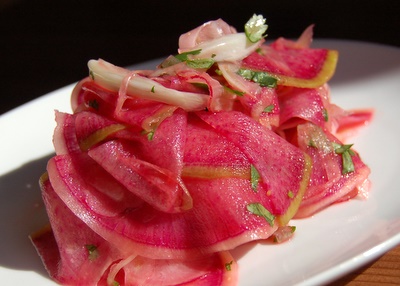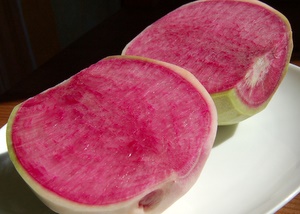 "What's this?" asked the cashier at Whole Foods.
"What's this?" asked the cashier at Whole Foods."That's a watermelon radish," I replied.
I couldn't believe my luck. I was in the produce section surrounded by beets, rutabagas, and turnips, when I noticed these little beauties. I've only had the watermelon radish once (this summer from our CSA), but I recognized its shy pink blush immediately. Could it be? I read the label and indeed -- these were watermelon radishes.
I grabbed the biggest one I could find and headed home to make a salad. Once you peel your radish and cut it in half, you'll understand the name.

I am sure there are tons of things you can do with this cute veggie. The only one I tried so far is slicing it paper thin on a mandolin for a salad. Sprinkled generously with salt and freshly squeezed lime juice, it's so good that it might take me a while to start exploring other ways. This one was really tame compared to the one we got this summer. I actually missed it's assertive bite, but it was still terribly yummy, particularly after all the months of winter food. If you find one with more bite than you are comfortable with, just let it sit in lime juice for 5-10 minutes. It will become much tamer.
There is no recipe here since this salad is so simple. Peel and slice a watermelon radish using a mandolin or adjustable blade slicer. You want VERY thin slices, so I don't recommend doing it by hand with a knife. Add whatever other veggies suit your fancy. This time I tried regular radishes and fennel. Add some chopped herbs. I used cilantro, but mint, parsley, and tarragon would all be great. Add a very generous squirt of fresh squeezed lime juice. For a good size radish, you'll need a whole lime. Sprinkle very generously with salt. If you don't add enough salt, the flavors won't pop. No, I didn't forget the oil. You can add some if you want, but it's not necessary. Toss and enjoy.
It's also good with avocado.


 I never thought it would take me a whole week to finally get to this post, but remodeling 3 rooms to make space for the baby seems to have put the rest of life on hold. Why can't decorating be as easy as cooking? Ok, let me rephrase it. Why can't it at least be as easy as baking (and I don't think baking is all that easy)? I hate shopping and decorating the way many women hate cooking. I am just lucky that decorating only has to happen every few years. I feel so terrible for all those poor souls who have to go through such suffering on daily basis for dinner.
I never thought it would take me a whole week to finally get to this post, but remodeling 3 rooms to make space for the baby seems to have put the rest of life on hold. Why can't decorating be as easy as cooking? Ok, let me rephrase it. Why can't it at least be as easy as baking (and I don't think baking is all that easy)? I hate shopping and decorating the way many women hate cooking. I am just lucky that decorating only has to happen every few years. I feel so terrible for all those poor souls who have to go through such suffering on daily basis for dinner. I have a confession to make -- I hate making stocks. When a recipe calls for chicken, beef, or veal stock, I open a can or a box. Unless of course, the stock is the star of the show and I am making chicken soup or tortellini in broth. Yes, yes -- I know that it's not hard. It's just boring and annoying. All that simmering, chilling, and degreasing, does not give me a sense of satisfaction. In fact, I usually feel bad afterwards because I have to throw away so much chicken. No matter how hard I try, I just can't like boiled chicken and can't find any creative uses for it.
I have a confession to make -- I hate making stocks. When a recipe calls for chicken, beef, or veal stock, I open a can or a box. Unless of course, the stock is the star of the show and I am making chicken soup or tortellini in broth. Yes, yes -- I know that it's not hard. It's just boring and annoying. All that simmering, chilling, and degreasing, does not give me a sense of satisfaction. In fact, I usually feel bad afterwards because I have to throw away so much chicken. No matter how hard I try, I just can't like boiled chicken and can't find any creative uses for it. A week after "
A week after "